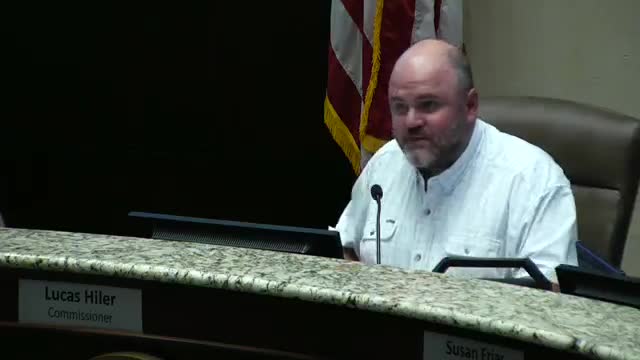City staff outlines dark‑sky rules, monitoring work and pursuit of International Dark Sky designation
October 06, 2025 | Boerne, Kendall County, Texas
This article was created by AI summarizing key points discussed. AI makes mistakes, so for full details and context, please refer to the video of the full meeting. Please report any errors so we can fix them. Report an error »

City planning staff presented an overview of Boerne’s Dark Sky Ordinance on Oct. 6, described required elements of commercial illumination plans, and outlined steps the city is taking to pursue recognition from the International Dark‑Sky Association.
Mister Bass, who led the dark‑sky briefing, said the ordinance prohibits uplighting, limits pole heights (20 feet for internal parking, 10 feet at property lines), sets total lumens per net acre for land‑use categories, requires full‑cutoff fixtures and specifies acceptable color temperatures (generally 2,700–3,000 Kelvin). For projects that require an illumination plan, staff reviews a photometric analysis (foot‑candles), a lighting schedule listing fixture make/models, and checks for off‑site light trespass.
Why it matters: commercial and public lighting affects nighttime visibility, neighbor light trespass and the city's eligibility for an international dark‑sky community designation. Staff said lighting levels and fixture selection are routinely reviewed during site‑plan or permit review for commercial projects, and that remodel or rebuilding triggers are available to require retrofits for existing, noncompliant lighting.
Staff steps toward designation: Bass outlined an outdoor public lighting inventory (a Google Earth/street‑view style dataset compiled by interns), a proposed sky‑quality monitoring station at Boerne City Lake, and ongoing outreach by the local Kendall County Friends of the Night Sky. Staff is soliciting letters of community support and cited a 2021 city council resolution that authorized pursuing the designation. Bass said the International Dark‑Sky Association designation is a multiyear process requiring ordinance compliance, monitoring and community engagement.
Enforcement and retrofit pathways: Bass said staff typically relies on remodel permits or cases where damage requires rebuilding (greater than 50% appraised value) to require retrofit to current standards; code enforcement responds to residential and commercial complaints about off‑site light trespass. Commissioners asked whether other municipalities offer retrofit incentives; staff noted some larger cities do but was not aware of local small municipalities with formal financial incentives. Commissioners encouraged outreach and discussed possible prioritization of street‑light retrofits using the inventory.
Next steps: staff indicated potential tweaks to the dark‑sky ordinance could come in a future UDC update and that they will continue collecting inventories, running sky‑quality monitoring and compiling letters of support as part of the application process.
Mister Bass, who led the dark‑sky briefing, said the ordinance prohibits uplighting, limits pole heights (20 feet for internal parking, 10 feet at property lines), sets total lumens per net acre for land‑use categories, requires full‑cutoff fixtures and specifies acceptable color temperatures (generally 2,700–3,000 Kelvin). For projects that require an illumination plan, staff reviews a photometric analysis (foot‑candles), a lighting schedule listing fixture make/models, and checks for off‑site light trespass.
Why it matters: commercial and public lighting affects nighttime visibility, neighbor light trespass and the city's eligibility for an international dark‑sky community designation. Staff said lighting levels and fixture selection are routinely reviewed during site‑plan or permit review for commercial projects, and that remodel or rebuilding triggers are available to require retrofits for existing, noncompliant lighting.
Staff steps toward designation: Bass outlined an outdoor public lighting inventory (a Google Earth/street‑view style dataset compiled by interns), a proposed sky‑quality monitoring station at Boerne City Lake, and ongoing outreach by the local Kendall County Friends of the Night Sky. Staff is soliciting letters of community support and cited a 2021 city council resolution that authorized pursuing the designation. Bass said the International Dark‑Sky Association designation is a multiyear process requiring ordinance compliance, monitoring and community engagement.
Enforcement and retrofit pathways: Bass said staff typically relies on remodel permits or cases where damage requires rebuilding (greater than 50% appraised value) to require retrofit to current standards; code enforcement responds to residential and commercial complaints about off‑site light trespass. Commissioners asked whether other municipalities offer retrofit incentives; staff noted some larger cities do but was not aware of local small municipalities with formal financial incentives. Commissioners encouraged outreach and discussed possible prioritization of street‑light retrofits using the inventory.
Next steps: staff indicated potential tweaks to the dark‑sky ordinance could come in a future UDC update and that they will continue collecting inventories, running sky‑quality monitoring and compiling letters of support as part of the application process.
Don't Miss a Word: See the Full Meeting!
Go beyond summaries. Unlock every video, transcript, and key insight with a Founder Membership.
✓
Get instant access to full meeting videos
✓
Search and clip any phrase from complete transcripts
✓
Receive AI-powered summaries & custom alerts
✓
Enjoy lifetime, unrestricted access to government data
30-day money-back guarantee

